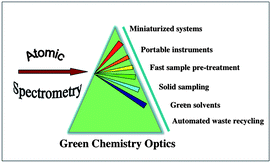As a result of the greater consciousness within the analytical community on the impact of chemicals on human health and environment, green issues are increasingly taken into account when choosing an established analytical method or developing a new one. Apart from typical analytical characteristics (e.g., sensitivity, limit of detection, repeatability, etc.), other features such as the amount of sample/reagents, operation time, use of energy-effective apparatus, waste production, etc. should be highlighted in order to meet the principles of Green Chemistry. Although conventional approaches for trace element analysis by atomic spectrometry usually involve well-established sample pre-treatments based on ‘wet chemistry’, and high consumption of gases, reagents, etc. is inherent to many techniques in this group, there are still many avenues where green issues can be implemented. For greening atomic spectrometry, green chemistry principles should be applied to every step of the analytical process, i.e., from sampling and sample pre-treatment to data processing. In this review, main pathways for greening atomic spectrometry such as downsizing of instrumentation, use of portable instruments, solid sampling, application of clean energies (ultrasound, microwaves, etc.) for sample pre-treatment, development of on-site, on-line and at-line approaches vs. typical off-line methods, application of modern extraction techniques (e.g., solid- and liquid-phase microextraction), green solvents and derivatization agents and use of chemometric tools for method optimization, signal processing, etc. are discussed in a critical way.


 Please wait while we load your content...
Please wait while we load your content...